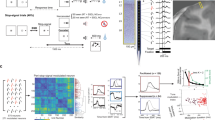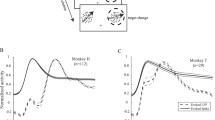Abstract
These experiments were designed to test the hypothesis that novel auditory stimuli lead to phasic and/or tonic increases in locus coeruleus (LC) cell firing, which may be a necessary condition for the occurrence of P300 potentials. Event-related potentials (ERPs) and LC unit activity were simultaneously recorded from three awake macaque monkeys exposed to an auditory “oddball” paradigm. Oddball stimuli resulted in probability-sensitive potentials resembling the human P3a component. Twenty-five percent (3/12) of LC units showed small phasic enhancements of LC firing after infrequent but not frequent tones. A comparison between histograms elicited by the two types of stimuli revealed significant effects of stimulus sequence. This pattern suggested a slight activation by rare tones, followed by a brief inhibition of firing in the subsequent trial. These data suggest that changes in LC activity during oddball paradigms are subtle, heterogeneous, and influenced by the subject's level of arousal and vigilance.
Similar content being viewed by others
References
Aston-Jones G, Bloom FE (1981a) Activity of norepinephrine-containing locus coeruleus neurons in behaving rats anticipates fluctuations in the sleep-waking cycle. J Neurosci 8:876–886
Aston-Jones G, Bloom FE (1981b) Norepinephrine-containing locus coeruleus neurons in behaving rats exhibit pronounced responses to non-noxious environmental stimuli. J Neurosci 8:887–900
Aston-Jones G, Foote SL, Segal M (1985) Impulse conduction properties of noradrenergic locus coeruleus axons projecting to monkey cerebrocortex. Neuroscience 15:765–777
Aston-Jones G, Chiang C, Alexinsky T (1991) Discharge of noradrenergic locus coeruleus neurons in behaving rats and monkeys suggests a role in vigilance. Prog Brain Res 88:501–520
Berridge CW, Foote SL (1991) Effects of locus coeruleus activation on electroencephalographic activity in neocortex and hippocampus. J Neurosci 11:3135–3145
De Sarro GB, Ascioti C, Froio F, Libri V, Nistico G (1987) Evidence that locus coeruleus is the site where clonidine and drugs acting at alpha-1 and alpha-2 adrenoceptors affect sleep and arousal mechanisms. Br J Pharmacol 90:675–685
Duncan CC, Kaye WH (1987) Effects of clonidine on event-related potential measures of information processing. Electroencephalogr Clin Neurophysiol [Suppl] 40:527–531
Foote SL, Freedman R, Oliver AP (1975) Effects of putative neurotransmitters on neuronal activity in monkey auditory cortex. Brain Res 86:229–242
Foote SL, Aston-Jones G, Bloom FE (1980) Impulse activity of locus coeruleus neurons in awake rats and monkeys is a function of sensory stimulation and arousal. Proc Natl Acad Sci US A 77:3033–3037
Foote SL, Berridge CW, Adams LM, Pineda JA (1991) Electrophysiological evidence for the involvement of the locus coeruleus in alerting, orienting, and attending. Prog Brain Res 88:521–532
Grant SJ, Aston-Jones G, Redmond DE (1988) Responses of primate locus coeruleus neurons to simple and complex sensory stimuli. Brain Res Bull 21:401–410
Hobson JA, McCarley RW, Wyzinski PW (1975) Sleep cycle oscillation: reciprocal discharge by two brainstem neuronal groups. Science 189:55–58
Johnson R Jr (1988) The amplitude of the P300 component of the event-related potential: review and synthesis. In: Ackles PK, Jennings JR, Coles MGH (eds) Advances in psychophysiology, vol 3. JAI Press, Greenwich, Conn.
Knight RT (1984) Decreased response to novel stimuli after prefrontal lesions in man. Electroencephalogr Clin Neurophysiol 59:9–20
Knight RT, Scabini D, Woods DL, Clayworth CC (1989) Contributions of temporal-parietal junction to the human auditory P3. Brain Res 502:109–116
Kubiak P, Rajkowski J, Luthin G, Aston-Jones G (1992) Tonic and sensory-evoked activities of noradrenergic locus coeruleus (LC) neurons in primate vary with discrimination performance in a vigilance task. Soc Neurosci Abstr 18:538
Lewis DA, Campbell MJ, Foote SL, Morrison JH (1986) The monoaminergic innervation of primate neocortex. Hum Neurobiol 5:181–188
Marrocco RT, Lane RF, McClurkin JW, Blaha CD, Alkire MF (1987) Release of cortical catecholamines by visual stimulation requires activity in thalamocortical afferents of monkey and cat. J Neurosci 7:2756–2767
McCarthy G, Wood CC, Williamson PD, Spencer DD (1989) Task-dependent field potentials in human hippocampal formation. J Neurosci 9:4253–4268
Olschowka JA, Molliver ME, Grzanna R, Rice FL, Coyle JT (1981) Ultrastructural demonstration of noradrenergic synapses in the rat central nervous system by dopamine-betahydroxylase immunocytochemistry. J Histochem Cytochem 29:271–280
Paller KA, Zola-Morgan S, Squire LR, Hillyard SA (1988) P3-like brain waves in normal monkeys and monkeys with medial temporal lesions. Behav Neurosci 102:714–725
Pineda JA, Swick D (1992) Visual P3-like potentials in squirrel monkey: effects of a noradrenergic agonist. Brain Res Bull 28:485–491
Pineda JA, Foote SL, Neville HJ (1987) Long-latency event-related potentials in squirrel monkeys: further characterization of wave form morphology, topography, and functional properties. Electroencephalogr Clin Neurophysiol 67:77–90
Pineda JA, Foote SL, Neville HJ (1989) Effects of locus coeruleus lesions on auditory, long-latency, event-related potentials in monkey. J Neurosci 9:81–93
Rajkowski J, Kubiak P, Aston-Jones G (1992) Activity of locus coeruleus (LC) neurons in behaving monkeys varies with changes in focused attention. Soc Neurosci Abstr 18:538
Rasmussen K, Morilak D, Jacobs BL (1986) Single unit activity of locus coeruleus in the freely moving cat. I. During naturalistic behaviors and in response to simple and complex stimuli. Brain Res 371:324–334
Reiner PB (1985) Clonidine inhibits central noradrenergic neurons in unanesthetized cats. Eur J Pharmacol 115:249–257
Smith ME, Halgren E, Sokolik M, Baudena P, Musolino A, Liegeois-Chauvel C, Chauvel P (1990) The intracranial topography of the P3 event-related potential elicited during auditory oddball. Electroencephalogr Clin Neurophysiol 76:235–248
Squires NK, Squires KC, Hillyard SA (1975) Two varieties of long-latency positive waves evoked by unpredictable auditory stimuli in man. Electroencephalogr Clin Neurophysiol 38:387–401
Squires KC, Wickens C, Squires NK, Donchin E (1976) The effect of stimulus sequence on the waveform of the cortical event-related potential. Science 193:1142–1146
Swick D (1991) The role of the noradrenergic nucleus locus coeruleus in modulating P300-like potentials. Unpublished doctoral dissertation. University of California, San Diego
Swick D, Pineda JA, Foote SL (1994) Effects of systemic clonidine on auditory event-related potentials in squirrel monkeys. Brain Res Bull 33:79–86
Trulson ME, Jacobs BL (1979) Raphe unit activity in freely moving cats: correlation with level of behavioral arousal. Brain Res 163:135–150
Yamadera H, Ferber G, Matejcek M, Pokorny R (1985) Electroencephalographic and psychometric assessment of the CNS effects of single doses of guanfacine hydrochloride (Estulic) and clonidine (Catapres). Neuropsychobiology 14:97–107
Author information
Authors and Affiliations
Rights and permissions
About this article
Cite this article
Swick, D., Pineda, J.A., Schacher, S. et al. Locus coeruleus neuronal activity in awake monkeys: relationship to auditory P300-like potentials and spontaneous EEG. Exp Brain Res 101, 86–92 (1994). https://doi.org/10.1007/BF00243219
Received:
Accepted:
Issue Date:
DOI: https://doi.org/10.1007/BF00243219




